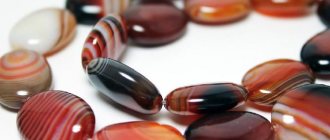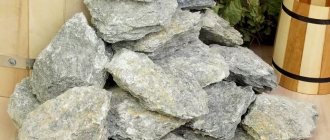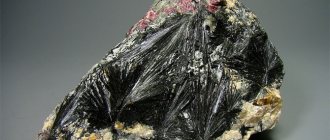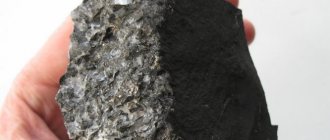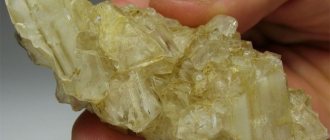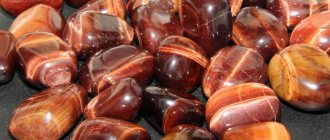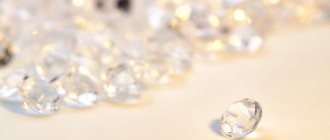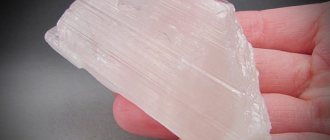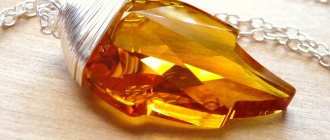Description
Sarinite is an opaque, dense stone with predominantly variegated colors.
It contains many components mixed together. Depending on which ones dominate, the color is obtained:
- For example, the dominance of azurite, gibbsite and malachite creates a turquoise-green-blue color scheme.
- Yellow-red nuggets with black speckling are the result of a composition of goethite, cuprite and limonite. They shine like diamonds.
The color of the stone can be almost black.
Zarinite
PROPERTIES OF ZARINITE STONE
ZARINITIS
In the fall of 2013, a spectacular ornamental stone appeared on the jewelry market from a new manifestation of malachite and azurite in the Altai Territory. The discoverers of the deposit named this contrastingly colored polymineral rock “sarinite.” Against the reddish-brown background of the host rock, consisting of cuprite and iron oxides, veins and phenocrysts of bright green, silky sheen, malachite and dark blue azurite stand out especially clearly.
This spectacular ornamental stone comes from a new occurrence of malachite and azurite, recently discovered in the Altai region. From the discoverers of the deposit it received the name “sarinite”. Against the background of dark-colored cuprite and goethite, the veins and nests of fine-fiber malachite and azurite with a spectacular layered and concentric-zonal pattern and silky shine look especially bright and attractive.
Gibbsite, azurite, malachite, cuprite, goethite, limonite (ball) The material for the ball was red-brown goethite-limonite rock with veins and phenocrysts of light blue gibbsite, bright blue azurite, green malachite and dark gray, with a metallic sheen, cuprite. This spectacular ornamental stone was brought from a recently discovered manifestation of malachite and azurite in the Altai region.
Zarinitis. A rare mineral. Found near Zarinsk (Altai). Green and blue are silky malachite and azurite, red-brown is limonite. The handsome specimen was sold to a private collection and will be donated to the Fersman Mineralogical Museum (Moscow)
Cosmic Sarinite In this stone you can see, as if in satellite photographs, the mountain landscapes of Altai, rivers, forests and lakes. Or maybe, on the contrary, it is a look up into space. Zarinite is like a slow-exposure shot of the night sky, passed through some clever Photoshop filters. And if you look at the piercing blue inclusions of azurite for a long time, it begins to seem that the stone is three-dimensional. I love this color. And almost the same noble shade - faceted Czech glass beads in the pendant. Zarinite was kept company by an ammonite - a shell from an ancient sea - and copper-plated wild olive seeds. Depending on how the light falls, there is more green in Sarinite..., ... then gold.
Altai pearl Zarinites are quite rare stones, and in fact, this name was given by the geologists themselves who found this deposit in Altai, near the village of Zarinsk. This mineral consists of such components as Limonite, Malachite, Azurite, Goethite, Gibsite. The jewelry itself is very impressive, for lovers of large necklaces with stones. Here you can see in all its glory all the beauty of the mineral, discover the mountain landscapes of Altai, rivers, forests, and maybe something of your own that will be revealed only to you.
Physico-chemical characteristics
According to the chemical and physical classification, the mineral sarinite is a ferrous oxide of complex composition. It contains azurite, goethite, gibbsite, crednerite, cuprite, limonite, and malachite. Plus compounds of iron, titanium, chromium, nickel.
But this is not a variety of any of the minerals, but an independent rock.
The complexity of the composition is reflected in the long multi-step formula.
Where is it used?
This rare stone is used only by jewelers, master decorators and mineral collectors.
The structure makes sarinite difficult to process; not every craftsman will risk taking on it. But the result is worth the effort: each product is unique. Most often they create jewelry such as bracelets, rings, earrings, and pendants. Blank cabochons are widely available.
Earrings with Zarinite in silver
Craftsmen grind balls, small plastic pieces, pyramids, and massage rollers.
Collectors of mineralogical collections can replenish them endlessly. This is facilitated by coloring. Although there is only one deposit.
Colors and varieties
The characteristic color of the stone is green with yellow or green tints. However, it can also be colorless, white or grayish. Rarer specimens have a spectacular “cat’s eye” pattern. New methods of radiation enhancement of gems are also constantly being introduced: under the influence of gamma radiation and calcination, they become soft green and begin to opalescent.
The translucent stone is close in beauty to garnet and rock crystal. Light green crystals can easily be confused with chrysotopaz. However, completely transparent prehnite is considered the rarest.
Yellow prehnite bracelet
The Australian mineral is of greatest value to jewelers. It has the effect of moonlight and literally sparkles from the inside, and its color can be onion, apple and even golden. Jewelry made from this rare stone is sometimes even more expensive than diamond jewelry. For this reason, the stone began to be often counterfeited, and such production was especially widespread in India.
Important! Natural prehnite has a synthetic counterpart called chrombonite. It has a deep color, but it costs much less, so unscrupulous jewelers pass it off as South American emeralds.
How to wear and care
Sarinite is rare, its properties have not been fully established, so you need to care for it constantly and carefully.
The main rule in handling stones is not to drop them . It is protected from proximity to other jewelry in the box.
Wash products with warm water, if necessary, use mild products (baby soap, for example).
Jewelry goes with a plain outfit, the color of which should match one of the shades of the stone. Organizing such a coincidence is not difficult.
Description and characteristics of the stone
Photo of prehnite stone
Although there are plenty of deposits of prehnite in nature, on the shelves of jewelry stores it is as rare as sarinite stone with a pattern reminiscent of a photograph of the night sky. The gem was named after the navigator Hendrik von Prehn from Denmark - it was he who found the gem at the Cape of Good Hope in the mid-18th century. However, in Asia the name “grape jade” has taken root, and in South Africa – “Cape emerald”. There are also names such as chiltonite, edel, adilite.
Prehnite is a mineral, a silicate of aluminum and calcium, but it also contains magnesium or manganese inclusions. In nature, it is often found in the form of small balls. However, there are gems in the form of crystals, and also resembling clusters, which is why they are also called grape jade.
Since prehnite stone is very hard, it lends itself well to cutting and is used for the production of jewelry and figurines. However, the mineral melts easily near a fire source and is destroyed in hydrochloric acid. In its natural form it is cloudy, but after cutting it emits a pearlescent sheen, close to a glass glow.
Reference. Although prehnite is a semi-precious stone, the cost of 1 carat can reach several hundred dollars. The transparent mineral, which is cut like diamonds, is highly valued.
Magic properties
Despite its “young” age, the stone has been studied by esotericists.
The following magical properties of sarinite have been revealed:
- Protects the house from uninvited guests and induced negativity.
- It is important as a family stone, guardian of the hearth and marriage ties.
- Suitable for people whose thoughts are constantly in confusion, negativity, and aggressiveness.
The magic of the gem is especially effective for those whose thoughts are pure and whose spirit is calm.
Zarinite is advised to be worn constantly by those who wish to develop superpowers (especially intuition). The best home amulet is a ball of stone.
Varieties and colors
The enchanting stone is mined in the only place on the planet. The deposit occupies 10 square km, located between the Chara and Tokko rivers on the border of the Irkutsk region with Yakutia. The mineral owes its name, which the stone justifies by its charming appearance, to the Chara River.
There are more than a hundred varieties of charoite. They are all unique in terms of color and pattern, which change due to admixtures of other minerals.
Several types:
- Veined-spotted. The most common type is lilac in color and has small veins and spots of pale green and golden color.
- Slate. Ornamental stones of this type have a light pearlescent luster.
- Rosette-shaped. The shades of such stones vary from lilac to violet, and the surface shimmers with mother-of-pearl. It is fascinating with its unusual structure (you can see rosettes of scales and leaves).
- Spotted radiant. On a rich purple background there are multi-colored inclusions (black, golden, gray-green). The stones have a fibrous structure.
- Lilac charoite-asbestos in appearance resembles another stone - “hawk's eye”.
The mineral is divided by grade. The highest grade (extra) stones have a clear pattern and no impurities. They are translucent, so they allow you to see the internal structure. It is from these varieties that jewelry is made.
Attention! There are varieties of charoite with admixtures of radioactive particles.
Therapeutic effect
Ural healers and lithotherapists have established the spheres of influence of sarinite:
- Improving brain function, strengthening memory.
- Elimination of stretch marks, bruises, bruises, spasms, rashes. To do this, the stone is applied to the desired place. At the same time, overall muscle tone and skin condition improves.
- Improvement of the liver and reproductive system.
- Inhibition of neoplasms.
- Purifying the blood, increasing iron levels in case of iron deficiency.
- Normalization of the psyche with a tendency to depression, aggression, hysterics.
Jewelry with sarinite is useful for those who want to lose weight. It suppresses appetite.
Jewelry in which a pebble comes into contact with the skin (beads, bracelet) eliminates itching, pain, and spasms.
Medicinal properties
Prehnite has medicinal properties. Therefore, jewelry with it not only looks beautiful, but also improves health. Lithotherapists advise wearing them when:
- Anemia
- Frostbite
- Gout
- Pyelonephritis
- Kidney stones
- Diseases of the heart and blood vessels
- Tumor formations
- Endocrine disorders
- Weak immunity.
It is not necessary to wear jewelry all the time for treatment. It is enough to wear them for a few hours every day. In this case, the stone should be located close to the diseased organ. For example, for kidney problems, it should be placed in a belt buckle; for headaches, earrings are recommended.
Note! Prehnite is also recommended for increasing physical performance. However, the krenoid is more effective in this regard. It is rich in iron, so it energizes and further cleanses the blood.
